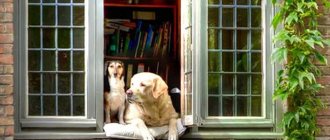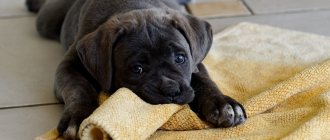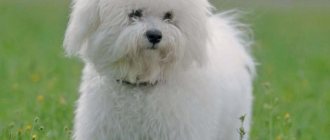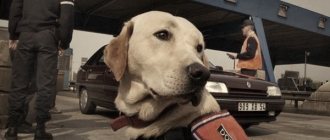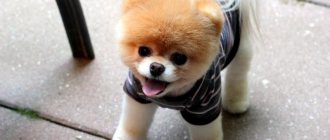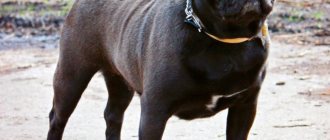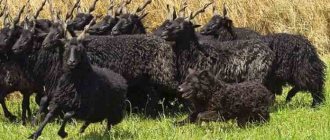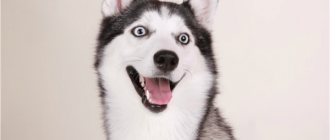Is it suitable for living in an apartment?
Active dogs, which include the Labrador, need adequate physical activity . First of all, the state of health, both psychological and physical, depends on this.
Any breed of dog can be kept at home if it is given proper attention. Frequent long walks, active outdoor games and training.
If the Labrador is not stressed, then in the first years of its life it will dump excess energy into destroying its home . How could it be otherwise if he is locked within four walls?
Over time, the dog imitates the lifestyle of its owners. Lazy people are not recommended to own Labradors. Without activity, dogs quickly gain weight due to metabolic disorders .
They become as lethargic as their owners, which is contrary to the nature of this breed.
Advantages and disadvantages
Before you start keeping a Labrador in an apartment, you should note several disadvantages of this decision.:
- the need to provide daily active load;
- the dog is recognized as a source of infections;
- the presence of long hair - during seasonal molting, the hair needs to be combed every day, intensive cleaning of the room and cleaning of furniture will be required;
- the need to devote a lot of time to the education process.
But all these disadvantages are fully compensated by certain advantages.:
- the appearance of a faithful friend;
- the labrador will happily go for a run with its owner in the morning;
- gets along well with children and can become a nanny;
- will not offend family members;
- With proper training, it performs security functions, although it is considered a completely non-aggressive dog.
How to accustom to a home environment
Babies may not initially be clean, which is a clear disadvantage of keeping them. Therefore, it is necessary to remove carpeting for a while.
Initially, you can use the playpen. But the dog should not be allowed to spend all his time there. There will be no cruelty in such a restriction - these are completely acceptable educational measures.
But whenever possible, kids should run, play and frolic. Anything that is dangerous must be removed from reach.
To keep a Labrador at home, you need to be patient . After all, we are talking about the energy of the animal and its constant tricks.
Sometimes this behavior is even tiring, but the owner’s task is to make his character more acceptable.
The puppy can be taken home only after it can feed itself.
Initially, he needs to be fed 5-6 times a day, then the number of feedings is gradually reduced.
Therefore, you need to rely on someone to do this. Otherwise, certain problems with the pet's health will appear.
Is it suitable for outdoor use?
Dog experts have different opinions about keeping a Labrador outdoors. This breed was bred as a hunting companion. Keeping it on the street should not mean that the dog is left to its own devices and is on an independent walk.
Loneliness has a negative impact on the animal’s psyche, so to keep a dog on the street, you must not deprive the dog of communication with family members.
Only joint walks and games compensate for the lack of attention.
Labradors can tolerate low temperatures. But for central Russia, for a dog to live on the street, it is necessary to take care of insulating the enclosure in winter.
The animal should have enough space to stretch out its paws and walk around . Always ensure there is clean water in the bowl.
An insulated enclosure, with lighting, and a large area is an acceptable option for keeping a Labrador outdoors.
Advantages and disadvantages
An aviary is the only option for keeping a Labrador outdoors.
The booth is not suitable for several reasons:
- A dog on a chain psychologically feels responsible for what is happening; it’s the same as a leash. She cannot relax and is always tense. The enclosure is like a cage, with a secluded place for the dog to rest and a small area for eating, with minimal space for activity.
- In an enclosure, the dog is better protected from precipitation: snow, rain. The wooden podium protects from dirt.
Among the advantages is that the dog is always in the fresh air . Seasonal temperature changes affect the formation of the coat gradually, which is completely different from apartment housing, centralized heating in the winter months.
This does not mean that a dog living on the street does not need to be brushed. This needs to be done less often.
A Labrador living outdoors needs more careful inspection . Enhanced protection against ticks and fleas. It is necessary to ensure that there are no other sick animals in the area.
Walking mode
One of the important features of keeping a Labrador in an apartment is productive walking. In the first 3 years, the pet's behavior is formed. Walks should not only be active, but also contain elements of learning.
Only a vaccinated puppy is taken outside. To get acquainted with the outside world, 20 minutes will be enough, in the future the duration will be increased. The amount of walking is determined by the age of the dog:
| Age, months | Number of walks |
| 3-6 | After every meal |
| 6-9 | From 3 to 5 |
| 9-12 | 2-3 |
| After a year | 2 times a day |
The dog should spend at least 1-2 hours in the fresh air. From the age of six months, the dog is taught to respond to its name. If he responds and runs up, reward him with a piece of treat. They begin to introduce the first basic commands:
- "place";
- "to me";
- «»;
- "sit";
- "lie";
- "near".
Expert opinion
Kuzmenko Olga Olegovna
Information about the expert
Ask a Question
Don’t rush to teach your puppy a new command; let him learn the previous one well first. If there is a body of water nearby, train your dog there. Retrievers are natural swimmers. The dog will be more willing to accept commands when he splashes out excess energy on playing in the water.
Basic rules of care
Training is the basis of mutual understanding between owner and dog . It also gives the pet an intellectual challenge. To live together with a dog in an apartment, it is important to develop self-control and develop stable behavior.
Loud barking, loud whining and running around will cause a lot of trouble for the neighbors.
You need to teach the puppy to calm down and strictly follow commands. Then there will be no problems with an adult Labrador in the apartment, even if he meets a cat at the entrance.
Active games and sports training are the key to ensuring that the dog gets the necessary physical activity . This is very important for apartment pets.
Being alone, they experience stress and try everything. So, the dog struggles with emotions. A tired dog goes to bed after a walk.
Curious puppies often chew on shoes and other accessible objects due to teething . You can ensure their safety by putting things away in advance.
All wires and cords must be kept out of reach. Small, fragile objects at an unattainable height.
Expert opinion
Kozhevin Semyon Kirillovich
Expert dog handler.
Labradors can be kept in an apartment provided that early training begins. First of all, the pet is taught to go to the toilet, to a specially designated place and not to bark loudly. If during training the animal does not succeed in everything right away, then under no circumstances should you raise your voice at him, as this can harm his psychological state. Daily walks are required; if the pet is taken for a walk, it will not cause any problems in the apartment.
First days at home - what should you do?
Before the puppy appears in a private home, you need to purchase a number of necessary things:
- toys;
- feed;
- bowls for food and water;
- dog bed or mat;
- brush.
Puppies don't know how to endure . Therefore, it will not be possible to avoid puddles, but the animal can be trained to go in a diaper or in a litter tray - you need to take care of the place in advance.
Features of the first days of life
Preparation for proper puppy care should begin even before the baby arrives.
- Decide in advance where the pet will be located in the house. There should be no drafts, sharp corners or crevices nearby where the pet can crawl.
- Put away small items, jewelry, and medications that your baby might swallow.
- If the house has laminate or parquet, it is advisable to cover the floor with a carpet or runner at first.
- Immediately buy everything you need to care for your little Labrador: vitamins, food, brushes, toys, dishes, a collar with a leash, etc.
Where is the dog's private place?
Dogs have distracted attention. This does not mean that they cannot concentrate and are easily distracted.
This indicates that the dog is always busy with something..
Either he sniffs something, or he watches the behavior of the owner. The next minute he’s already chasing his tail. At the same time, he can quickly take off from his place for his favorite toy if he calls out to it.
The owner and his family are the most important people for a pet. The animal will not leave them without attention, no matter what they do. Happy to join you for lunch and take part in the game.
Labradors are people-oriented by nature . They will keep company while watching TV, sitting closer to their person. They will obediently wait for the time to walk.
Given these points, the dog should have its own place in the house so that it can relax and not be distracted . A secluded corner is chosen for the pet, even before the puppy arrives in the home.
Positive associations are formed through encouragement.
CAREFULLY!
You should never scold a dog when it is in its place. Children and other family members should not be allowed to handle the puppy.
“Place” will become an effective command so that the dog does not interfere when other people come to visit and does not get in the way.
Main characteristics
The height at the withers for males is 56-57 cm, for females – 54-56 cm. The standard acceptable body weight for males is 27-40 kg, for females – 27-35 kg. The average life expectancy of dogs of this breed reaches 13 years.
The Labrador has a massive build: powerful paws, a wide muscular back and a well-developed chest. Due to these body features, Labradors are strong and resilient dogs that are able to run fast, jump over obstacles, swim and even dive.
There is a misconception that the Labrador is an excellent watchman who will skillfully protect the house from unwanted guests, but this is not so. Despite its large size, the Labrador is a poor watchdog because it is not characterized by aggression.
How to feed?
It is difficult to answer unequivocally what diet to choose for a dog without consulting a veterinarian and assessing the state of health.
The markets offer a huge range of dry food and wet canned food for large breeds of dogs. You can feed your Labrador with natural food by first creating a balanced menu .
Dry food is easy to use. It is enough to calculate the required daily intake based on the age and weight of the animal. You should always make sure your dog has clean water in his cup. Sometimes the diet can be varied with wet food.
Natural nutrition is difficult in that it is necessary to include in the diet daily:
- meat;
- cereals;
- vegetables.
If your pet develops an allergy, it will take a long time to find out which product. Excluding one by one, then the other. It is necessary to regularly give your dog vitamins.
You need to be careful with dairy products, they can cause diarrhea.
For the first few weeks, puppies should be fed the same food they received from the breeder. If this is not dry food, then you should provide a similar menu as much as possible.
Mixing homemade food and dry food is harmful . They have different contents of useful elements and proteins, which disrupts metabolism.
Feeding your dog chips, sweets and any food from the table is prohibited. Sugar is bad for all dogs. Fried foods cause cardiovascular disorders. Fatty – disrupts the functioning of the gastrointestinal tract.
Labradors do not need a varied menu . The main thing is that they receive a sufficient amount of vitamins, proteins and carbohydrates from food. Sometimes you can treat your dog to a beef bone or carrot.
Dogs are not allowed:
- onion;
- mushrooms;
- nuts;
- chicken and fish bones;
- citrus;
- berries.
Labrador - characteristics and description of the breed
Big, kind, friendly, calm, active, positive - all these are the characteristics of the Labrador dog that most often come to mind when it comes to this breed. Next, we will give a detailed description of the appearance and character of the Labrador dog and talk about the characteristics of its temperament.
Description of the Labrador Retriever dog breed
The Labrador Retriever is a dog with a well-developed but compact body, harmoniously built, without excess weight. A distinctive feature of the breed is its developed intelligence and expressive, intelligent eyes of a dark shade. An active, dexterous dog never shows aggression towards people, in any situation he is human-oriented and wants to please him. In the worldview of a dog, a Labrador and a person should be together and inseparable.
Types of Labrador Retriever by color type
The European breed standard describes three main colors that a purebred purebred Labrador can have. One of the Labrador colors has several varieties. The coat of all these varieties should be thick, short, hard to the touch, and glossy.
Types of Labrador colors recognized by the breed standard:
- Solid black. Large black Labrador dogs are not so common, but they are purebred representatives of the breed.
- Fawn Labrador Retriever. The most common coat color. According to the FCI standard, fawn color includes dogs whose coat color varies from light cream to fox-red. However, at an exhibition, a bright red Labrador retriever may be rejected by experts and recognized as not meeting breed standards.
- Brown. This beautiful color can be called liver or chocolate.
Important: all types of colors must be free of spots. All that is allowed is a small white spot on the dog's chest.
Related article:
Cane Corso - character of the breed, behavior, attitude towards the owner and children . Perhaps the Labrador breed, whose distinguishing characteristic is kindness, but you need a reliable guard, then we advise you to pay attention to the Cane Corso breed. Read about it in a separate article.
Types of breed by nature of use
In the USA, where Labradors are considered the most popular breed, there are two types of dogs:
- "English type." Show dogs bred for the show ring. In America they are called English Lab, in England - Show lab. Distinctive characteristics of this type: clearly defined “otter” tail, wide skull, wide nose, expressive “kind” eyes.
- "American type". Working dogs for use in the field. Dogs with a less dense build, without a pronounced otter tail, with a narrower head.
Both types are distinguished by friendliness, good nature, positive temperament and activity.
Breed varieties not recognized by the FCI standard
Deviations from the standard include animals with an unusual color or special coat.
- Labrador retrievers with the fluffy gene. Fluffy (fluff, translated from English) gene is responsible for the structure and length of the coat. Dogs with this genome look like plush toys and have beautiful curly hair. Such dogs are kept exclusively as pets and are not allowed to participate in exhibition activities.
- Gray retrievers. Gray dogs are recognized only in the USA. In our country and in Europe, this is a breed marriage. This coat color was obtained as a result of mating chocolate dogs with representatives of a breed of a different shade. The color of the coat looks beautiful and varies from silver to ash.
- Spotted dogs. Animals with spots or tri-color Labradors are also a breed defect.
- Dudley colored dogs. Fawn dogs with pink or chocolate “lining” around the lips and eyes can get good marks at shows, but they are not awarded titles. They look like albino dogs, but they do not have the health problems associated with albino dogs.
Important: unlike “dudleys,” albinos do not have “rimming,” and their eye color is necessarily blue.
Labrador mixed breed
This category includes puppies resulting from the mating of individuals of two different breeds, one of which is a purebred Labrador.
Let's list the most interesting hybrids:
- "Taxo Labrador." Taxolabras and labrotaxes are the result of crossing two breeds that are completely different from each other. These mestizos have an unusual appearance and a unique character, in which you can find features of dachshunds and Labradors. The mixture turned out to be contradictory. Dogs love to swim, like retrievers, but are afraid to go out in the rain, like dachshunds. They have a sly, impudent face, but the dogs behave with reserved dignity. It is difficult to guess which breed's traits will appear more in this union.
- "Labrodoodle." An interesting cross between a poodle and a labrador. The creators of the hybrid were unable to achieve recognition of this interesting species. Externally, the offspring from a hybrid mating can look like both poodles and retrievers.
- “Likadors” are a cross between a husky and a labra. Active and cheerful pets are completely unsuitable for either the role of watchmen or the role of security guards. These are companion animals.
- Spaniel hybrid. As a result of this mating, cheerful and friendly animals with a funny exterior are obtained.
- Mixed Labrador and Rottweiler. Mating representatives of these two breeds produces offspring with an unpredictable character.
- Hybrid of Husky and Retriever. Friendly mixed breeds can exhibit husky willfulness and be prone to running away and disobedience.
Important: none of the hybrids are allowed for exhibition activities!
Labrador - characteristics of the breed
How often should you go for walks? How long should you walk?
Retrievers were bred as hunting dogs, capable of following a person on a hunt for a long time. Run after shot game over a long distance, overcoming any obstacles in your path. These large dogs are distinguished by their endurance.
Therefore, it is advisable to walk your dog two or three times a day.
In the morning, this can be a jog with your pet or an active game, which will give the animal energetic relief.
Duration of at least half an hour . Better is more. A tired dog will not smoke while the owner is not at home.
Evening exercise should be combined loads. The dog must be given commands while walking. Exercises for endurance. Running behind a bicycle or practicing sports equipment (agility, Frisbee) makes the walk exciting.
Labradors love to swim . Swimming does not put a lot of stress on the joints, but it is active physical work for the dog.
How to properly care?
Labradors are fairly unpretentious dogs. Special care only needs to be taken for the puppy, since he is susceptible to various diseases and problems. Dogs of this breed are very clean, so caring for them at home is not difficult. Let's take a closer look at how to properly care for your Labrador.
Walking mode
Labradors are very active dogs . They need to splash out their energy somewhere, so walks are an integral part of the healthy lifestyle of these dogs. To meet their needs, you need to walk them at least twice a day for an hour.
A leisurely walk on a leash in the park is not what Labradors need. They should be allowed to play and run without a leash. The best option would be to find a friend for your dog, the same breed or similar in behavior. Then the Labrador will receive the positive emotions and activity it needs.
Do you need clothes? Harness or collar, muzzle - which is better?
The Labrador has a dense coat and undercoat. Thick wool protects against sudden changes in temperature and allows you to comfortably endure minor frosts.
They do not need clothes for walking . A raincoat or a thick raincoat for a walk in the forest in the off-season will provide additional protection for the dog from ticks and thorns. Will keep your wool from getting wet when it rains.
A small puppy is taught to walk on a leash with a harness . You can start with a leash. The advantage of the harness is that it reduces the strain on the neck thanks to the straps on the chest. The pressure is on the powerful body. The harness is a great option for jogging.
In the city you need to learn to walk on a leash with a dog . Through it, the dog feels every movement and twitch more intensely.
How to prepare a home and place for a puppy
You should prepare in advance for the arrival of a new family member. It is important to learn how to care for your Labrador puppy before he arrives. Small representatives of this breed are very active. Fragile or dangerous items will need to be removed. During play, a pet can not only break something, but also accidentally harm itself. The period of maximum activity in a Labrador lasts approximately two years, and only constant monitoring of the dog and educational work will keep the house intact.
The puppy must have its own personal space. For sleep and relaxation, it is best to use a soft lounger with a removable cover, which will have to be washed from time to time.
For information. Labrador is one of the few breeds that simply love to sleep on a pillow.
You will also need to properly equip the place for eating. It is very important to have two bowls, one of which will be used for food, the other for water. Even at the initial stage, you will need some pet care products:
- Comb.
- Massage brush.
- Personal towel.
- Cosmetics for dogs.
- Claw cutter.
- Collar.
- Leash.
- Special toys.
The list can be replenished or modified depending on the preferences of not only the owner, but also the dog.
You need to prepare in advance for the puppy's arrival
How to toilet train a puppy?
Puppies go to the toilet immediately after sleeping and eating. You can teach them to relieve themselves in a specific place using a diaper or tray. It is necessary to monitor the puppy and put him on a diaper prematurely. When he does his business, they reward him with a treat.
You need to gradually teach your dog to relieve himself outside . Up to six months, the puppy can always ask himself. Therefore, you should not remove the diaper, but you should try to make the dog learn that this should be done outside.
To do this, you should go out with him more often, after eating..
How to teach cleanliness
Labrador retrievers should be taught to be clean from the very first days. This will require a lot of strength and patience, but in general the animal is understanding and loves praise.
You need to choose a suitable place for the toilet; a tray with a low edge is suitable for this.
Puppies usually go to the toilet after changing their activities. This could be sleeping, playing or eating.
You can only walk outside with a vaccinated puppy . Therefore, you need to take care of comprehensive vaccination.
The first walk can be stressful, but this is not a reason to keep your dog indoors all the time. Be sure to use a leash and collar, then the animal will not run away.
When using the elevator, you should be careful that the puppy does not end up on the other side of the doors. Initially, walks will be just an excursion, an acquaintance with an unknown world.
At first, you need to walk outside for no more than twenty minutes, then the time can be gradually increased.
By six months, the puppy may be exposed to long periods of walking and jumping over obstacles.
It is not necessary to keep him on a leash all the time, but then you should choose a suitable place to play. There is no need to allow long descents from the stairs.
Then all the limbs will be correctly positioned and the spine will be straight, which is very important for dogs of this breed.
How to trim claws and when?
A Labrador's nails get worn down when the dog walks outside. As they age, all dogs need to have their hair trimmed a couple of millimeters. You can start at one month of age if the puppy is inactive.
IMPORTANT!
The first procedure for trimming claws is best done by a specialist so that he can show the owner how to do it correctly.
Use a nail clipper; for a small puppy, nail clippers are suitable . The main danger of the procedure is that when cutting the claws, you can hit a blood vessel and bleeding will begin.
A bleeding cut should be immediately treated with a solution of potassium permanganate or hydrogen peroxide.
A Labrador must be taught all hygiene procedures from puppyhood . While the dog is small it is easier to conduct them. Be sure to reward the dog for exemplary behavior.
Feeding
A balanced diet appropriate for the dog’s age is an integral part of proper care for a Labrador puppy. When the owner takes the baby into the house, he should find out what kind of food the puppy was fed by the breeder. The same food is given to a Labrador after moving to a new owner’s house. When purchasing food, make sure that the packaging contains the following information: “intended for feeding puppies of large breed dogs.”
Characteristics of the ideal dry food for a Labrador puppy:
- absence of chicken, which can provoke an allergic reaction;
- food enriched with fish oil and natural vegetable oils;
- the food contains glucosamine, which is necessary for the full development of the dog’s skeleton;
- food is enriched with vitamins and microelements.
How much food per day should a puppy receive:
- 300 grams up to three months of age, and this portion is divided into 5-6 doses;
- from three to five months, the daily amount of food is increased to 400 grams, dividing the portion into 3-4 doses;
- from 6 months, the daily volume of food is increased to 500 grams, giving the puppy 2 meals;
- from the age of one year, the puppy is transferred to an “adult” diet: the daily portion does not exceed 700 grams.
When calculating the daily intake of dry food for a particular brand, you need to take into account the information about the dosage of the product indicated on the packaging.
In cases where preference is given to natural feeding, the following products are gradually introduced into the puppy’s diet:
- boiled meat (chicken, turkey, veal, beef);
- moderate fat cottage cheese;
- milk;
- kefir;
- cereals: rice and buckwheat;
- vegetables and fruits: zucchini, pumpkin, carrots, apple.
The daily volume of food consumed is calculated as follows: 200-300 grams of milk, 100-150 grams of cottage cheese, up to 150 grams of rice porridge, 250-350 grams of meat. Vegetables are given in the amount of 100 grams per day, seasoned with a teaspoon of vegetable oil. The puppy is given food in 6 doses. From the age of four months, food portions are increased by 1.5 times, giving the puppy 4 meals.
From 6 months the baby is transferred to three meals a day. In the morning, you can give your Labrador puppy a portion of cottage cheese with kefir with a total weight of 0.5 kilograms. During the day, the dog is fed porridge, the portion of which is 250 grams. In the evening, the Labrador is given 0.5 kilograms of meat mixed with 200 grams of any vegetables allowed for the dog.
From 8 months the puppy eats twice a day. In the morning, the dog is given cottage cheese with kefir (500 grams). In the evening, the animal is given porridge with meat or meat with vegetables. The amount of meat is 500 grams, and the other component is 200 grams.
Regardless of the type of food, the owner must provide the pet with round-the-clock access to fresh drinking water. For water, prepare a separate container, the contents of which must be changed several times a day.
How to clean your ears?
A healthy animal has clean ears; there is no need for frequent procedures. The only thing you need is to regularly examine your Labrador's ear to assess its condition.
An unpleasant odor and discharge are a sign of infection . Frequent ear cleaning disrupts the natural microflora, reducing protective mechanisms.
To carry out the procedure, soak a cotton pad in warm water and roll it inside the ear. If there are barely noticeable traces of earwax, yellow in color, there is no need for cleaning. Excessive brown earwax discharge requires its removal.
Before the procedure, the dog must be calmed . To stroke the area of the ears at their base. This massage will relieve tension and soften wax in the ear canals.
Cleansing products may vary:
- powder;
- medicinal lotion;
- drops.
Under no circumstances should you clean your Labrador's ears with hydrogen peroxide . It can cause a burn to the eardrum.
Labrador's ears are floppy. The outer and inner areas should be carefully wiped, without sudden movements, without twisting the ear. A bandage soaked in cleanser or warm water is suitable for this.
Special cotton swabs for dogs will help gently clean the ear canals.
Labrador Ear Care
A Labrador's ears should always be clean and free from any unpleasant odor. To do this, once a week you need to clean them with a small cloth made of natural material. The material must first be moistened with a small amount of vegetable oil or water (wring out thoroughly).
You can use a special substance to clean dog ears. Under no circumstances should you replace a cloth with a cotton swab.
If during cleaning you notice an unpleasant odor or inflammation in the ear, contact your veterinarian as soon as possible. You should also seek help if your pet shakes its head, constantly tilts its head to one side, and scratches its ear. Such symptoms can be caused by a foreign body entering the depths of the ear canal.
Grooming. How long does shedding last?
The Labrador's coat has a dense structure and a thick undercoat, thanks to which it tolerates low temperatures and can swim in cool water.
In girls, shedding is more intense before estrus, due to hormonal changes . Males shed during the changing seasons.
Labradors cannot be cut or shaved. This disrupts natural heat exchange. In hot weather, the dog will overheat, and in winter it will freeze.
Labradors need to be brushed frequently . The coat is constantly renewed; if the coat is not taken care of, the dog will develop skin problems.
For combing, use a comb with fine metal teeth. The Furminator is a comb with a small blade that will delicately thin out the fur and remove fluff from the undercoat.
During shedding, the dog needs to be brushed daily . Typically, shedding lasts from one to two weeks. This is a painless period for the dog. A new cover is formed immediately.
Bathing during shedding will help get rid of old fur faster.
NOTE!
If the new coat looks dull, and the old one is coming out in clumps, you need to increase the amount of nutrients and proteins in the Labrador’s diet.
No need to change your diet. Vitamins in drops or tablets will help your pet’s body cope. Prolonged shedding with similar symptoms is a reason to contact a veterinarian.
Breed Features
The Labrador is a dog-friend, a companion dog. The breed is universal, because these dogs can be used as guide dogs, hunting assistants, and even nannies. It is surprising that the characteristics of these dogs are so diverse and include so many canine “professions”.
Labradors are very friendly and obedient dogs with a stable psyche. They respond well to training.
Ideal for living in a large family with children. They have a great time in the company of people and love everyone indiscriminately. So, perhaps, the only negative that can be found in the description of the breed is their inability to distinguish enemy from friend. Labradors are not suitable as a watchman, unless they lick a creeping robber to death.
These dogs love to swim. Nature has rewarded them with a special paw structure. They have membranes, which allows the dogs to move in the water faster than a duck and not get tired for a long time while swimming. Their tail is similar to that of an otter. Labradors spin it in the water and thereby change the direction of movement. Dogs' fur is also adapted to water procedures - it is thick and multi-layered, and the bottom layer is covered with fat.
The back of the Labrador's body has a reinforced muscle corset, which allows them to jump high and far. The recorded jump record for a Labrador is 8 meters in length. However, this advantage is overshadowed by possible joint problems as the dog ages.
When carrying something in their mouth, Labradors do not damage it by clenching their teeth. This canine feature is called a “soft mouth.” This is very important for future owners with small children. Labradors are quite healthy and are not afraid of the cold. They have an excellent memory, are quickly trained and try to take a leading position in the owner’s family.
How to bathe and how often should it be done?
The homeland of Labradors is the island of Newfoundland. As island dogs, they love to bathe.
A healthy animal does not have a distinctive odor; if the dog’s fur smells bad of a dog, this may indicate fungal diseases or that the dog has not been washed in clean water for a long time.
Frequently washing your pet in the bath is not recommended. Hard running water disrupts the functioning of the sebaceous glands.
You should bathe your Labrador no more than once every two to three months . Use only special shampoo for dogs that does not dry out the skin. If the dog still needs to be washed unscheduled, then the shampoo is replaced with coat conditioner.
Do not blow dry your Labrador . The wool should dry naturally.
After bathing, the dog can be dried with a soft towel or cotton diaper.
Short story
The Labrador Retriever is a breed that was developed in the late nineteenth century in Canada. There is unconfirmed information that a spaniel, a pointer and a small Newfoundland, a large short-haired dog, participated in the selection of the breed.
The first Labradors came to Europe from the Canadian island of Newfoundland, when a colonel from Great Britain became seriously interested in these strong, hardy and intelligent dogs, which became famous as valiant hunters and skilled divers. The Colonel brought several Labrador Retriever dogs to the Old Continent, and these animals immediately gained popularity among the English aristocracy.
Despite the fact that today there are officially 3 colors of Labrador dogs (black, chocolate, fawn), more than 100 years ago only black Labradors met the breed standard, and a few years later, chocolate ones too. The fawn Labrador was officially included in the breed standard only in 1924.
How to brush your teeth?
For dogs, you can add a special liquid to the water that prevents the formation of plaque and freshens breath. It will not replace brushing your teeth, but it will support your oral health.
You need to brush your teeth with toothpaste for dogs . Brushes can vary in size and have a massage effect.
Before cleaning, wash your hands thoroughly, and let the dog try the paste. A gum massage is performed. Over time, the dog will get used to manipulations with its muzzle and will allow it to brush its teeth more thoroughly.
Teeth should be brushed no more than once a week and no less than once a month . An alternative to regular teeth cleaning is a bone.
How to care for a puppy
Anyone who has ever dealt with dogs knows how to care for a Labrador puppy. This process is simple, you just need to adhere to a number of rules that relate to the living conditions and health of the baby.
Air temperature and humidity
The main source of heat for puppies is the mother's body, so it is important to ensure that the room temperature is high enough. For newborns, it is advisable to maintain it at a level of +24. +26 °C, and closer to the sunbed itself - all +29 °C. With each week the puppy grows up, the temperature should be lowered by 2-3 degrees. At the age of 4 weeks, babies are ready to calmly tolerate normal room temperature.
Cleanliness and hygiene
Caring for and raising a Labrador puppy necessarily includes taking care of the baby’s hygiene. To ensure that your dog is always well-groomed and clean, you must:
- brush his fur every day (buy a soft brush for this, the baby will love this massage);
- bathe periodically as needed;
- Wipe your eyes with cotton wool every day. If tearing or inflammation is noticeable, you should seek help from a doctor;
- monitor the claws of the babies and trim them in a timely manner, otherwise the babies may injure the mother;
- Lubricate his paws with wax-based ointment before a walk so that the delicate pads do not get hurt, and when returning home, wipe them with a damp cloth or napkin.
Baby's health
Labradors are famous for their good health, so the owner only needs to ensure that external factors do not harm his pet. The main signs of health problems in your baby are:
- lack of appetite;
- low temperature;
- no weight gain;
- squeak and cry of the baby;
- diarrhea.
The last symptom can occur for two reasons:
- when switching to complementary foods. Due to hormonal changes in the baby’s body, its microflora is disrupted. The puppy's excrement changes only its consistency, but not its color or smell. To improve the situation, you need to give your baby probiotics, which can be purchased at any veterinary pharmacy;
- when contracting an infection. In this case, it is important to promptly seek help from a specialist, otherwise a fragile immune system may not be able to cope with the load.
Also contact your veterinarian if your baby's weight does not increase in a timely manner. For the first 14 days, you need to weigh the baby daily, then once every 3 days. By the end of the first 20 days of life, the puppy's weight should triple its birthday weight.
- the puppy is healthy;
- at least 10 days have passed since the last deworming;
- Over the past three days, the baby's temperature has been within normal limits.
Further vaccinations should be carried out according to the schedule provided by the veterinarian.
Attention and love
Labrador is a positive breed that needs affection and attention from its owner, as if in the air. You need to pet him regularly and talk to him, otherwise the baby will get upset. First of all, give the puppy a name. Typically, Labradors get used to their name in 2-3 days and respond to it very quickly. One of the manifestations of love for kids will be walking together. You can start with 10-15 minute walks twice a day, but a couple of times a week make forays into parks or vacant lots where the puppy can run around without a leash.
Cage for a Labrador in an apartment
A dog crate can become a full-fledged secluded place, or vice versa – a cause of stress. Labradors dote on people.
For full psychophysiological development, a dog needs to move and communicate with a person . In many situations, a crate is considered the only solution for a dog's safety.
For example, when there are small children at home who may unknowingly torment the puppy, other animals, repairs.
A dog cage should be larger in size than a regular carrier . Choose a large one with a solid base so that the dog does not accidentally knock it over or move it from its place.
The acceptable height of a cage for a Labrador retriever exceeds 60 cm. The dog should feel free in the cage, be able to stretch its paws, and stand without bending its head.
Choose a cage for growth and from a durable material that is easy to care for.
Features of outdoor maintenance
To form a stable psyche in a dog, it needs socialization. A Labrador can live in an enclosure or on the street, but you should not expect that it will become a watchdog.
For this breed, aggression is a pathology, an undesirable behavior . If for some reason it is not possible to keep a dog in the house, then when setting up an enclosure, you need to be prepared to pay no less attention to it.
A dog shouldn't feel lonely.
It is allowed to let the dog run around the territory, under supervision, as often as possible . Keeping them outside does not replace the need for long walks, active games, and intense physical activity.
It is worth taking care of seasonal temperature changes and insulation.
Choose the right place for the enclosure: secluded, partial shade, not in a draft . It is better that this is the inner part of the yard, not facing the entrance. Otherwise, the dog will worry every time and whine when people come or leave the house.
A big dog means a big responsibility. A small plush puppy is irresistible, but you need to realize that a small Labrador will grow up quickly, psychologically remaining a puppy until the age of three.
Labrador - character description
You can often come across the statement that a Labrador's character traits depend on its color. They say that black Labradors have a calmer, more reserved character, while the red Labrador Retriever dog has an uncontrollable temperament and hyperactivity. This is one of the myths!
In fact, the character of Labradors does not depend on the color of the dog's coat. Regardless of color, dogs of this breed have a friendly, sweet character. They are not characterized by aggression towards humans and other pets. Because of these breed qualities, dogs are used in canistherapy, as guides for blind people, and in nursing homes.
A well-trained adult Labrador Retriever will never leave the person he is helping. The dog will be patient, obedient and diligent. Labradors do an excellent job as a helper dog for a person with disabilities.
Athletically built dogs have endurance, courage and good sports characteristics. They are used in search and rescue work; dogs can accompany a person on long hikes and hunts, and run with him over short and long distances. Representatives of this breed have proven themselves well in dog sports: agility, overcoming obstacle courses, obedience.
A trained adult Labrador Retriever has the ability to carry objects very carefully and carefully, which makes it possible to use dogs to neutralize explosive objects. And its ability to find and track objects by smell makes animals indispensable in customs activities and drug control.
Speaking about the nature of a Labrador, we need to mention the natural stubbornness of these pets. They can be stubborn and refuse to do what their owner requires of them. Most often this happens if the dog wants to pick up something inedible on the street. Lab owners note that a leash during a walk is needed not so that the dog does not pose a danger to others, but in order to pull the dog away from what he is trying to pick up from the ground in time.
Labrador's attitude towards children and other pets
An active, youthfully playful breed of dog retains a youthful temperament in adulthood, which children really like. Dogs happily participate in all children's games and amusements, keep company on walks and are ready to frolic for hours.
Smart pets understand that small children may accidentally cause pain while playing, but they will not bite back. Labradors will prefer to move to a safe distance if the baby wants to pull the dog by the tail. Dogs comment on their dissatisfaction with the child’s actions by quietly barking and do not use their teeth and claws.
There is no need to talk about whether the Labrador is a dangerous breed or not. With proper training and education, a Labrador will easily become a responsible nanny for a baby and a best friend for a teenager. History has recorded cases where dogs protected children by keeping them away from sources of danger.
The dog's friendly attitude extends to all members of the owner's family, which includes other pets. Labradors sincerely love everyone and believe that those around them reciprocate their feelings. Therefore, dogs do not chase the owner’s cats, they can be friends with them and sleep in an embrace.

